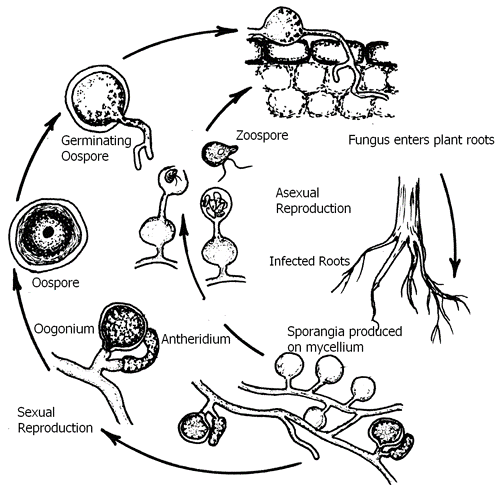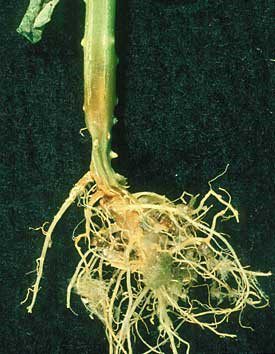Pythium species are fungal-like organisms (Oomycetes), commonly referred to as water molds, which naturally exist in soil and water as saprophytes, feeding on organic matter. Some species can cause serious diseases on greenhouse vegetable crops resulting in significant crop losses.
Pythium infection leads to damping off in seedlings and crown and root rot of mature plants. Several species, including P. aphanidermatum, P. irregulare and P. ultimum, are known to cause damping-off and crown and root rot in greenhouse cucumber, pepper and tomato crops.
There are no Pythium resistant varieties available although some varieties may have disease tolerance. Over watering, poor root aeration, root injury and improper root zone temperatures can weaken the crop and, thus, trigger Pythium outbreaks. Saturated growing media that are either too cold or too warm can be conducive to Pythium build up and spread in water and recirculating nutrient solution. Plants grown under optimal environmental conditions are less susceptible to Pythium than plants grown under poor conditions.
Disease cycle
The disease can be introduced into a greenhouse in plug transplants, soil, growing media, plant refuse and irrigation water. Greenhouse insects such as fungus gnats (Bradysia impatiens) and shore flies (Scatella stagnalis) can also carry Pythium. It spreads by forming sporangia, sack-like structures, each releasing hundreds of swimming zoospores (Figure 1). Zoospores that reach the plant root surface encyst, germinate and colonize the root tissue by producing fine thread-like structures of hyphae, collectively called mycelium.
These hyphae release hydrolytic enzymes to destroy the root tissue and absorb nutrients as a food source. It forms oospores and chlamydospores on decaying plant roots which can survive prolonged adverse conditions in soil, greenhouse growing media and water, leading to subsequent infections.

The disease cycle of Pythium damping-off and crown and root rot of greenhouse vegetable crops.
Symptoms
‘Pre-emergence’ damping-off causes seeds and young seedlings to rot before they emerge from the growing medium, while ‘post-emergence’ damping off kills newly emerged seedlings. In ‘postemergence’ damping-off, the pathogen causes a water-soaked, soft brown lesion at the stem base, near the soil line, that pinches off the stem causing the seedling to topple over and die. In mature plants, Pythium causes crown and root rot, where plants suddenly wilt when weather turns warm and sunny and when plants have their first heavy fruit load.
Often, upper leaves of infected plants wilt in the day and recover overnight but plants eventually die. In the root system, initial symptoms appear as brown to dark-brown lesions on root tips and feeder roots and, as the disease progresses, symptoms of soft, brown stubby roots, lacking feeder roots, become visible (Figure 2). In larger roots, the outer root tissue or cortex peels away leaving the string-like vascular bundles underneath. The rot also occurs in the crown tissue at the stem base. In cucumber, diseased crown turns orange-brown in colour, often with a soft rot at the base; brownish lesions extending 10 cm up the stem base may be seen.

Pythium crown and root rot in greenhouse cucumber showing orange discolouration of the crown area and rotted roots and root tips.
Monitoring & Identification
Routinely monitor your crop for slightly wilted plants and check wet areas in the greenhouse where Pythium is more likely to be present. It occurs mostly in spring, at early fruit set and later in the season on mature plants. In cucumber, Pythium can also occur in the summer on young plants brought in for the fall crop. Monitor plants for wilting, and in cucumber, check the stem bases for discoloration. Always confirm Pythium diseases by sending representative plant samples with roots, crowns and foliage to a plant diagnostic laboratory.
Integrated Disease Management
Disease management consists of a combination of cultural, biological and chemical tools to control and/or manage crop diseases effectively. Cultural controls keep Pythium from reaching the roots while biological and chemical controls inhibit or suppress Pythium in the root zone.
Sanitation: Field soil, debris, pond and stream water, and roots and plant refuse of previous crops can contain Pythium. Follow a strict greenhouse sanitation program throughout the year and a thorough year-end clean up. Clean and disinfest all interior greenhouse surfaces and equipment including tools, hoses, walkways, carts, totes, troughs, tanks and water supply lines. Use sterile propagating media. Remove dying plants by placing them directly into plastic bags for disposal away from the greenhouse.
Irrigation water: Untreated water from rivers or streams poses great risk for Pythium introduction, while treated municipal water is considered safe. Water storage and nutrient tanks need to be disinfected periodically and covered to prevent Pythium contamination.
Resistant varieties: Although there are no resistant vegetable varieties, some vigorous varieties may have some tolerance to Pythium. Contact your local seed/seedling supplier for further information on Pythium tolerant varieties.
Biological and Chemical Control
Prevent the diseases by practicing integrated disease management strategies based on cultural and biological controls. Use fungicides as a last resort at the onset of disease. Rotate registered fungicides with different chemical groups and strictly follow label directions to avoid resistance development in Pythium. Routinely monitor plants and evaluate the level of disease control if fungicides are used. Stop fungicide treatment and get professional advice if fungicides fail.
Source: W.U. Plant Biology.
